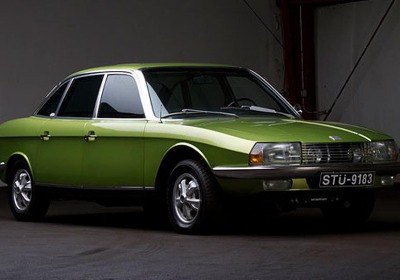NSU Ro80 to cross the block at Auctions America
Fri, 09 May 2014
There seems to be no shortage of rarities in the 450-car John Scotti Collection that's currently rolling across the block in Auburn, Ind., at the Auctions America sale. While the lion's share of the collection consists of American muscle, there are definitely a few cars in the sale that will make classic-car aficionados do a double take. One of those is the NSU Ro80.
Autoweek readers need no introduction to the Ro80 -- some one you probably own a poster of this futuristic car or may have always admired its technical audacity -- though it is undoubtedly a rare sight on these shores. A lime green 1969 example of this sedan will be offered for sale today in Auburn, at no reserve. So what are these all about?
Before NSU was swallowed up by Volkswagen in 1969, the West German automaker had a reputation for taking chances and for building small, affordable cars that exhibited a lot of technical ingenuity. While NSU began to experiment with rotary engines with the NSU Sport Prinz and the Spider, which we recently took for a spin, these first cars were testbeds for its first serious mass-market project, as NSU sought to gain confidence in building rotary engines.
In 1967 the company debuted the Ro80, which used a version of the 995-cc two-rotor engine making 113-hp, also found in the pint-sized Sport Prinz. The front-wheel drive sedan was designed by Claus Luthe (a name which should be familiar to BMW fans) and an innovative semi-automatic transmission. The sleek Ro80 also offers inboard disc brakes all on all four corners, an independent suspension front and back, and rack-and-pinion steering; all features that effectively made it a decade ahead of its time.
The weak point, unfortunately, was the engine, and warranty claims from earlier cars took a heavy financial toll on the company. The rotary engines were prone to fail at the rotor tip seals, which tended to wear out due to over-revving. A solution was eventually created, but that didn't stop a lot of engines from having to be replaced early in a car's life. Another problem was the engine's thirst; fuel economy was marginal. Reputation-wise, the damage was done, though the car remained in production with very few changes till 1977.
The Ro80 was never sold in the U.S., and its numbers on this side of the pond are said to be in the low two digits, with examples residing mostly in museums. Driver-grade cars on the continent usually received engine swaps from more common cars of the day, but in later years with Mazda's adoption of rotary engines, a few examples have received rotary transplants to preserve the engineering spirit of the car. One of its most enduring legacies is its design, which carried over in virtually all Audi sedans and can still be seen in the proportions of the greenhouse of Audi cars.
Very little is stated about this particular example in the auction description, aside from the fact that it has a black vinyl interior. Mileage is unstated, though the interior and exterior appear to be in good condition, with no obvious cosmetic faults. This does not appear be a driver-grade example that was later treated to a restoration; such an undertaking would be brave (let's call it that), given the relatively low values for surviving examples. As in: this Ro80 is estimated to bring between $10,000 and $14,000, though there aren't too many comparables in North America for there to really be a predictable market for these automobiles. And even though this is an internationally monitored auction, only the bidders on the ground in Auburn will be able to get a true sense of this car's condition.
If this example sells anywhere within the estimate range, and if the car does not have too many unaddressed issues, it should make a nice addition to a well-maintained collection... which will probably have a dedicated garage with a lot of automotive tools. An audacious buy for a novice, but if the bidding stays on par with European sales, we figure there will be plenty of enthusiasts at the auction who would love to learn what made these futuristic sedans the Car of the Year in Europe in 1968.
By Jay Ramey

